How To Change My Router Dns Settings
The Domain Name System (DNS) is used to translate the easy-to-understand and remember web addresses that we are familiar with, to their "truthful" numerical IP addresses that computers understand: for example translating the domain name proprivacy.com to its IP(v4) address of 104.20.10.58.
This DNS translation process is usually performed by your ISP, but when using a VPN, all DNS requests should be sent through your encrypted VPN tunnel, to be handled by your VPN provider instead.
In that location are a number of reasons why y'all might desire, or need, to change your DNS settings (that is, change the default DNS server used by your Operating System to handle DNS requests). These include:
- Improving privacy by preventing your ISP from handling DNS requests. This can happen fifty-fifty when using a VPN (this is known equally a DNS leak). Irresolute your DNS settings to a 3rd-political party provider is, therefore, a good safety precaution.
- Using a SmartDNS service.
- Fixing internet connectedness issues – in relation to VPN, when a VPN connection suddenly drops for some reason, it is common for the DNS settings to remain pointing at the VPN provider'south DNS server. To reconnect to the internet (including to reconnect the VPN!) it is sometimes necessary to change the DNS settings back to using a third political party server).
- Evading censorship – irresolute DNS settings tin can effective at evading DNS level censorship / DNS poisoning by ISPs.
Fortunately, changing your DNS settings is pretty easy...
Back upwards your DNS settings
Before changing your DNS settings, information technology might be an idea to note down your existing settings and shop them somewhere safe, and so you tin easily reset them should you need to. I can't actually think of a reason why yous might demand to practise this, but information technology is probably a sensible precaution, anyhow.
What settings should I use?
If you are changing your DNS settings to something in particular, then you should already know the settings yous require (for case a SmartDNS provider will tell you lot the settings you need in order to muse its service).
If you are changing DNS settings for a more than general reason, so y'all can use a public DNS server such as those run past Google Public DNS, Open DNS or Comodo Secure DNS. Google DNS, in particular, can be useful for quick-and-dirty solutions, equally its settings (DNS server addresses) are very easy to recollect (eight.8.8.viii and eight.eight.4.4).
Google, however, is Google, and information technology will spy on your DNS requests in order to rails what you get upward to on the internet in social club to target you with ads.
If you are at all interested in privacy, then a much better option to Google and the other Us-based commercial providers listed above is OpenNIC. This is a non-profit, decentralized, open up, uncensored and autonomous DNS provider. Designed to take back power from governments and corporations, OpenNIC is run by volunteers, and provides a completely unfiltered DNS resolution service, with DNS servers located all across the world.
For more data about OpenNIC, delight encounter hither.
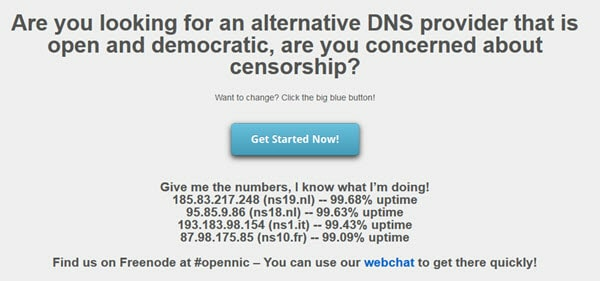
In this article we will use case DNS settings provided past OpenNIC. Equally I am continued to a VPN when visiting its website, the suggested settings are based on the IP address of my VPN server, which suits my privacy agenda just fine
Windows
- Right-click Outset -> Control Panel (in Windows 7 and earlier, left-click Get-go instead).
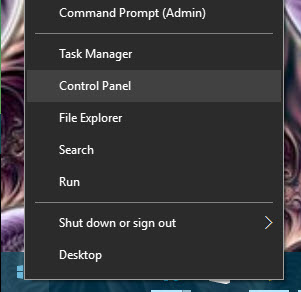
- Go to "Network and Sharing" (or "View network condition and tasks" if in Category mode).
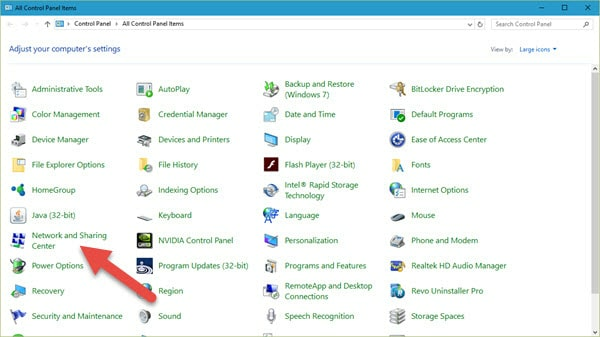
- Click "Modify adapter settings".
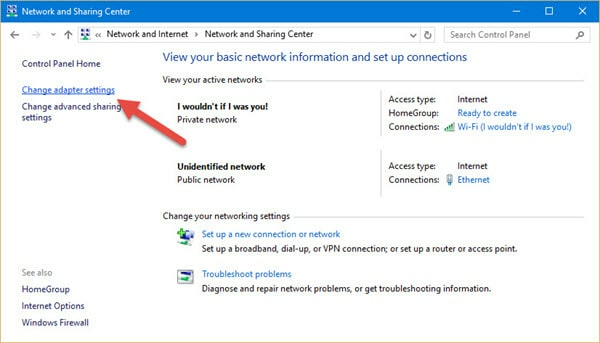
- Right-click on your internet connectedness -> Properties.
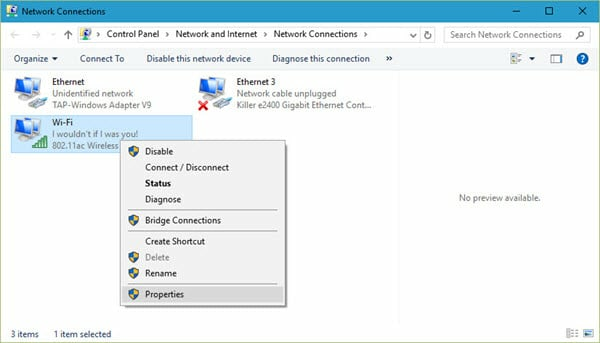
- Click on (highlight) "Net Protocol Version 4 (TCP/IPv4)", and so select "Properties".
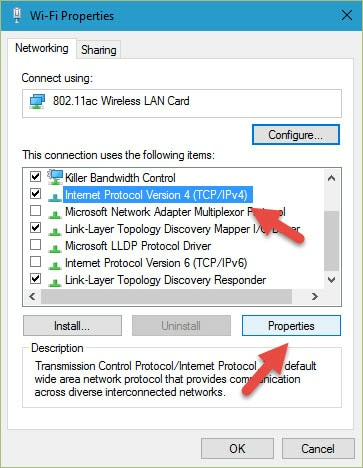
- Ensure the "Utilize the following DNS server addresses" radio push button is checked, and input your new DNS settings into the "Preferred DNS server" field (you can go ahead and fill in the "Alternate DNS server" field as well, just this is only a backup server address, so is not strictly necessary). Click "OK".
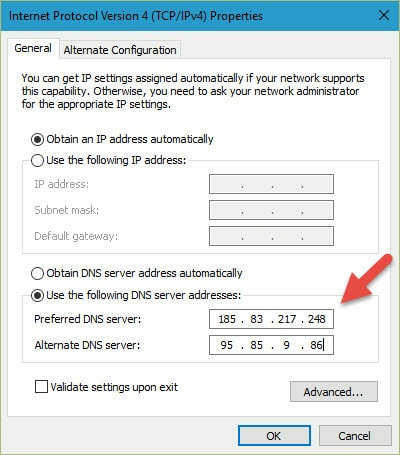
Here I am using the Netherlands server addresses provided by OpenNIC - (Optional) Disable IPv6.
Now might be a skilful time to foreclose IPv6 leaks by disabling IPv6 domain resolution (please meet here for a total discussion on this subject). On the "[Internet connection] Properties" screen (run across step v), untick the box next to "Internet Protocol Version 6 (TCP/IPv6)", and then hit "OK".
Windows users might also want to cheque out the DNS Jumper app discussed subsequently in this article.
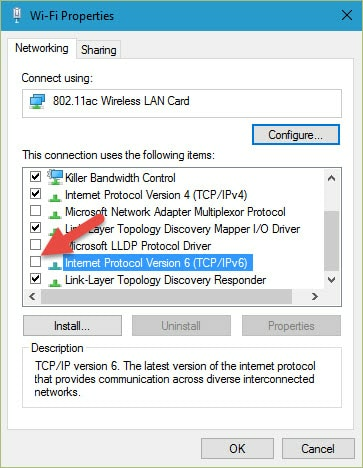
MacOS
- Open "System Preferences".

- Click "Network".
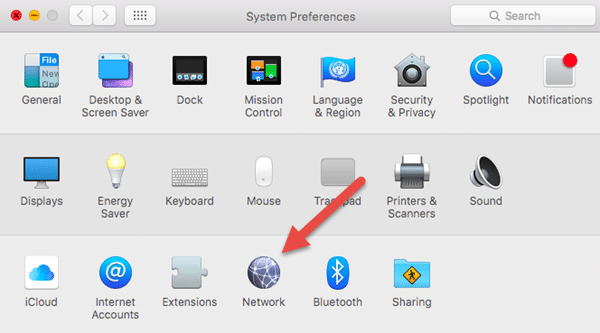
- Select your internet connectedness, and then click "Advanced".
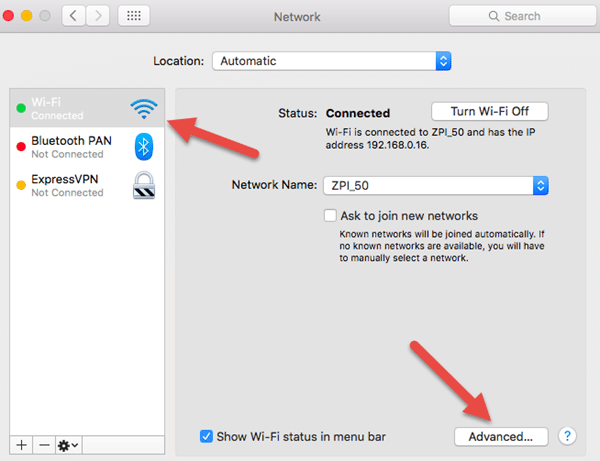
- Switch to the DNS tab, and use the – symbol to remove existing servers and the + symbol to add new servers. OSX will preference servers from pinnacle to lesser of this list. When yous are done, click "OK".
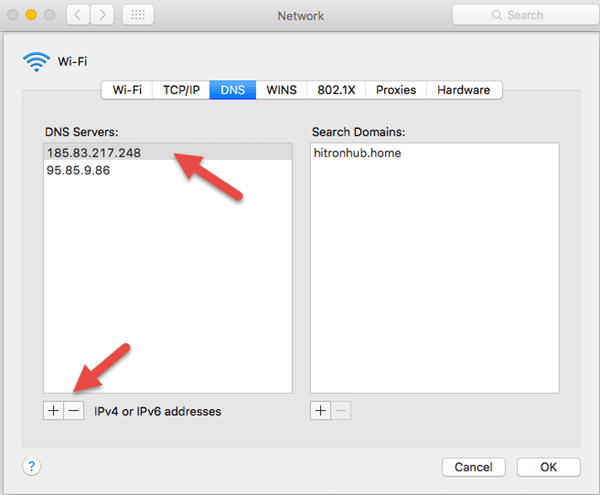
- (Optional) Disable IPv6.
Now might be a skillful time to prevent IPv6 leaks by disabling IPv6 domain resolution (please see hither for a full discussion on this subject). To practice this, switch to the TCP/IP tab and select "Link-local only" from the "Configure iPv6" dropdown menu.

Linux (Ubuntu)
- Go to System Settings -> Network.
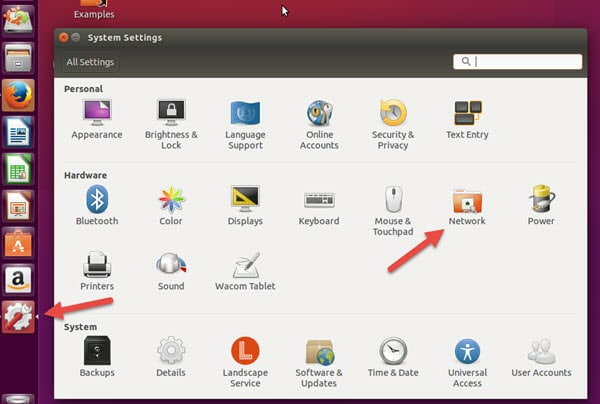
- Select your internet connection, then click "Options..."
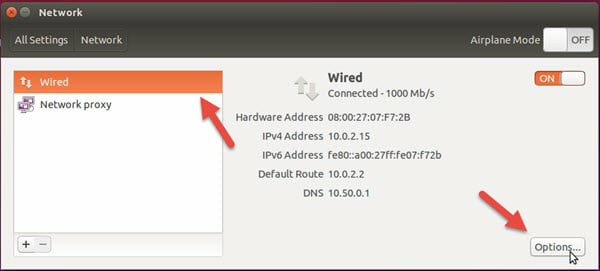
- Switch to the "IPv4 Settings" tab. Change "Method:" to "Automatic (DCHP) addresses only", and so add your new DNS server address to the "Additional DNS Servers:" field, separated by a comma. Hit "Save". It may be necessary to disconnect then reconnect to your network and restart your browser before the new DNS settings take effect.
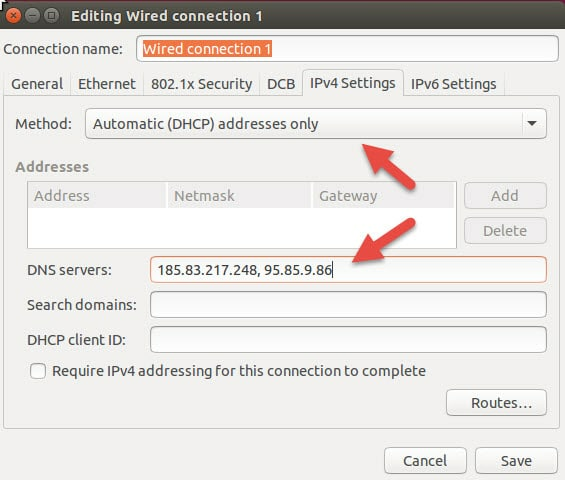
- Optional) Disable IPv6.
Now might be a expert fourth dimension to prevent IPv6 leaks by disabling IPv6 domain resolution. To this, switch to the "IPv6 Settings tab and alter "Method:" to "Link-local merely".
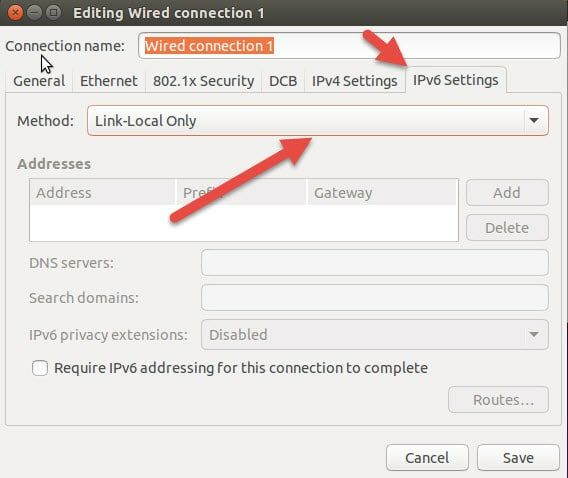
iOS (iPhones and iPads)
In iOS yous can change the DNS settings for specific Wi-Fi networks (such as your home network), only this volition have to be set up for each network you connect to. As far equally I know, it is not possible to change the DNS settings for mobile networks.
- Open the Settings app -> Wi-Fi.
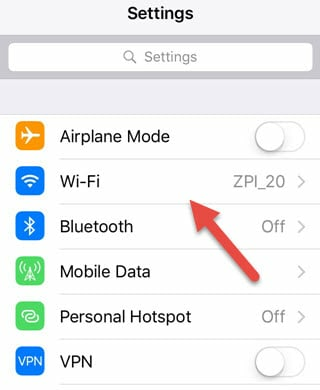
- Tap the Data ("i") button next to your Wi-Fi connection.
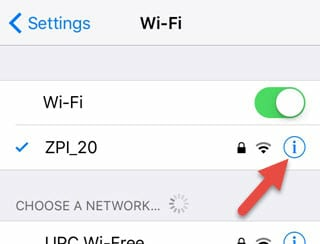
- Ensure the "DHCP" tab is selected, then curl down to "DNS" and tap on the numbers to the right. When the keyboard appears, enter your new DNS settings. When y'all are done, press "Back". Note that a reboot may be required before the new DNS settings have effect.
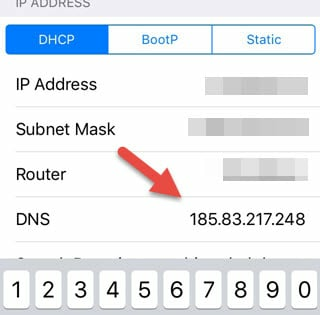
Android
On unrooted Android devices you lot can alter the DNS settings for specific Wi-Fi networks (such every bit your home network), but this will have to be set up for each network you connect to. There is no way to change DNS settings for mobile (3G and 4G) networks.
Users of rooted devices tin can download a number of apps such equally DNSet Pro (a free version is also available, which is limited to Google Public DNS servers), which can dynamically change DNS settings beyond both Wi-Fi and mobile networks.
Note that some "no root" DNS changer apps also exist. These work by creating a local VPN on your device (not an external VPN), and might be useful for evading DNS-based censorship, only will conflict with a regular VPN.
Beneath are instructions for changing the DNS settings for Wi-Fi networks on unrooted devices. Note that Android devices run many different versions of the OS, and many are heavily skinned. Details may therefore differ slightly on your device.
- Open the Settings app and tap Wi-Fi.
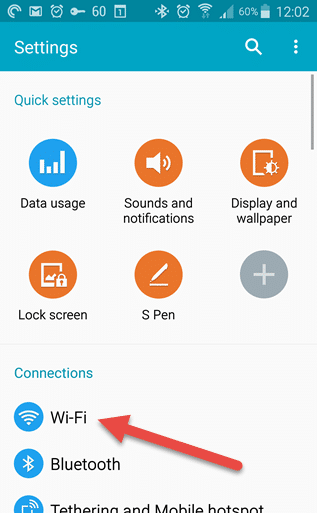
- Long-press the active network, then tap Modify network config -> Evidence Advanced options.
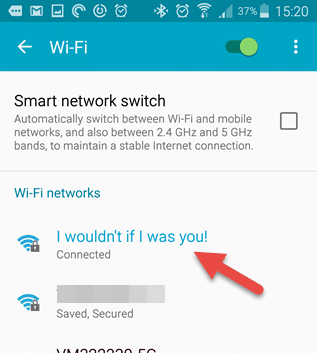
- Scroll down until y'all meet "IP settings", so change this to "Static" in the drib-downwardly menu. If yous scroll downwardly a lilliputian further, you should now see "DNS 1" and "DNS two" fields – enter your new DNS settings here, then touch on "Save".
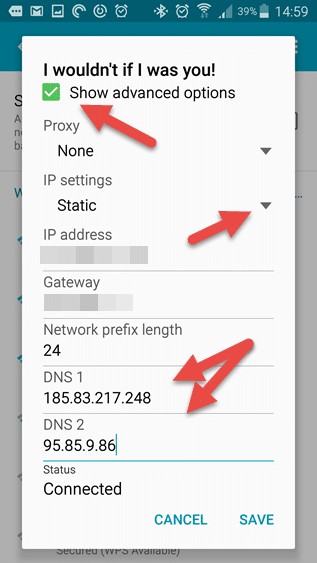
Routers (DD-WRT)
You can change the DNS settings of any router using its web interface. This is normally pretty intuitive, and so for example purposes, I volition bear witness you how to alter the DNS settings of a DD-WRT router.
- In your web browser, type in the IP address of your router in order to admission its admin folio. Netgear, D-Link, and about DD-WRT flashed routers usually have the default router IP address 192.168.0.1. Belkin routers usually have the default router address 192.168.2.1. If none of these work, please see hither for more details on how to discover your router's IP accost.
Ensure the Setup -> Basic Setup tab is selected.

- Scroll down to Network Setup -> Network Accost Server Settings (DCHP) and enter your new DNS settings in the Static DNS one and Static DNS 2 fields. In the Static DNS iii field you can enter another DNS address of your pick, utilise 0.0.0.0 (fallback to your ISP DNS), or 10.0.0.0 (a not-usable IP if you don't desire to utilise any other servers).
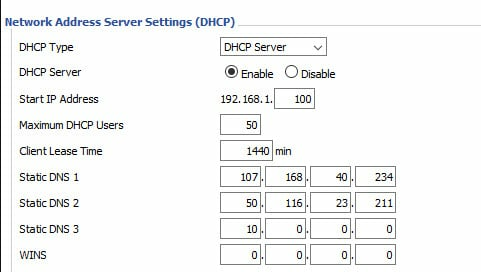
Other devices
Y'all tin can change the DNS settings for just well-nigh every internet-capable device, including smart Tv set's, games consoles, streaming devices and IoT gizmos. Although this guide is intended to be "complete", I think information technology off-white to say that in that location are far too many such devices to cover here and private manufacturers will probably take their own specific setup/configuration guides.
Appendix
DNSCrypt
What SSL is to HTTP traffic (turning information technology into encrypted HTTPS traffic), DNSCrypt is to DNS traffic. Unfortunately, DNS was non congenital with security in heed, and information technology is vulnerable to a number of attacks, the most of import of which is a "man-in-the-middle" attack known as DNS spoofing (or DNS cache poisoning), where the attacker intercepts and redirects a DNS request.
This could, for example, be used to redirect a legitimate request for a banking service to a "spoof" website designed to collect the account details and passwords for unsuspecting victims. The open up source DNSCrypt protocol solves this problem past encrypting your DNS requests, and authenticating communications between your device and the DNS server.
DNSCrypt is available for most platforms (mobile devices must be rooted/jailbroken), but does require support from your chosen DNS server.
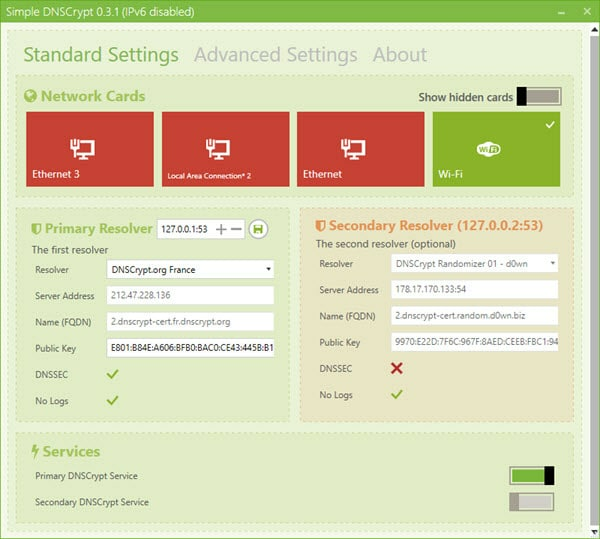
Annotation that DNSCrypt is non required if using a VPN, as all DNS requests should be sent through the encrypted VPN tunnel straight to your VPN provider'due south DNS servers.
DNS Jumper (Windows)
Changing DNS settings regularly tin can be something of a hurting (particularly in Windows). Luckily, at that place's an app for that! DNS Jumper is a lightweight utility (with no installation required) that makes changing your DNS settings a doddle.
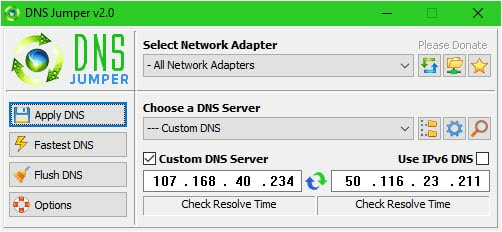
You can select from an extensive list of DNS providers, or specify custom servers
Using a Smart DNS service
With a Smart DNS service, yous'll be able to unblock streaming content on pretty much whatsoever cyberspace-enabled device, such as your smart Goggle box or games console. A Smart DNS service isn't a VPN, and actually has more in common with a proxy that sends your traffic through a remote server in order to mask your original IP address.
And because Smart DNS services just redirect your DNS queries through its servers, they're particularly handy for folks who want access to international content libraries without impacting the traffic from all of their other devices!
Smart DNS services accept plenty of other benefits, as well:
- Unblocking power – Admission geo-restricted content on any of your devices with a Smart DNS service, fifty-fifty ones that don't natively support VPNs!
- Low-impact – Unlike a VPN, a Smart DNS service doesn't encrypt your traffic, mimizing its bear upon on your connection speeds.
- Versatility – you'll exist able to configure your Smart DNS service on any of your devices without having to run through a potentially complicated setup process.
A smart compromise
If y'all're interested in checking out a Smart DNS service, you'll want to bear in mind that they don't encrypt your traffic like a regular VPN service. As a result, they're ameliorate for unblocking streaming services on your Smart TV than they are at augmenting your online privacy.
How to use a Smart DNS service
Configuring a Smart DNS service might seem daunting if you're unfamiliar with the procedure, merely there'due south really nothing to it!
First things first, option a VPN provider that offers a Smart DNS service. I'thou using ExpressVPN's MediaStreamer – it'south a great service that's piece of cake to use, quick to set up, and included free with your subscription!
Then, determine whether you're going to use MediaStreamer with your VPN router or Windows device.
Using MediaStreamer with your router
Accessing MediaStreamer via a router is quick, piece of cake, and covers a whole household's worth of devices in ane get! Even so, it's important to remember that y'all can't geo-hop from location to location whilst using MediaStreamer.
- First, you'll want to make sure you've fix ExpressVPN on the router your devices are continued to.
- And then sign in to the router running ExpressVPN.
- Once you lot've logged in, caput to the domicile screen and select the ellipsis ("...") option on the device group you lot'd like to use MediaStreamer with.
- Click "All Locations".
- Then "MediaStreamer".
Voilà, the device grouping you selected is now using MediaStreamer!
Using MediaStreamer with your Windows device
Y'all'll need to register your IP accost on the ExpressVPN site earlier you lot access MediaStreamer via your laptop or PC. Luckily, this only takes a minute! One time you have, ExpressVPN will recognize your IP address and allow you to apply MediaStreamer without a fuss.
- Once you've registered your device's IP address, head to the ExpressVPN setup folio and enter your login details if prompted.
- Here you'll observe the MediaStreamer DNS server IP addresses – and you'll need these details a bit afterwards, so don't close the tab!
- Then, on your Windows device, press the Windows key and the R fundamental at the aforementioned time to open Run prompt.
- Dial in "ncpa.cpl" and then "OK".
- Yous should see the Network Connections window – correct-click the net connection you're using.
- Click "Properties".
- So, in the Properties menu, double-click the "Internet Protocol Version 4" selection and uncheck the "Internet Protocol Version 6 (TCP/IPv6)" option.
- Next, navigate to the "Full general" tab and select "Use the following DNS server addresses".
- Remember the MediaStreamer IP addresses from earlier? Hither's where you'll enter them – in the "Preferred DNS server" and "Alternate DNS server" boxes.
- Hit "OK", and you're all fix!
Smart DNS VPN alternatives
At that place are plenty of VPNs out at that place with their very own Smart DNS service – and information technology's not always piece of cake to pick out your favorite. To brand things easier, we've put together a list of our top VPN recommendations, which you'll find in the tabular array below. In improver, our in-depth guide to VPN Smart DNS services covers each of these height-notch providers in more detail.

From $6.67/Month
Has the best Smart DNS service. A lightning-fast service that tin unblock most any streaming platform y'all indicate information technology at, from anywhere! Also offers a thirty-day coin-back guarantee.
- ProPrivacy TrustScore:
- ten out of x
- Simultaneous connections
- 5
- Free trial
- No
- Server locations
- 160

From $2.29/Calendar month
Has the all-time user-friendly Smart DNS service. With defended streaming servers and sleek apps for all platforms, as well every bit a generous 45-day money-back guarantee.
- ProPrivacy TrustScore:
- 9.9 out of 10
- Free trial
- Yes
- Server locations
- 113
- Simultaneous connections
- 7

From $2.30/Month
Has the best value Smart DNS service. Offers unlimited simultaneous connections and admission to a long listing of streaming services, and a thirty-solar day money-back guarantee.
- ProPrivacy TrustScore:
- nine.eight out of 10
- Simultaneous connections
- Unlimited
- Free trial
- Yes
- Server locations
- 108

From $3.66/Calendar month
Has the all-time budget Smart DNS service. With helpful guides and a calendar week-long free trial, users have access to global streaming sites. Plus a 30-twenty-four hours money back-guarantee.
- ProPrivacy TrustScore:
- 9.7 out of 10
- Server locations
- 39
- Simultaneous connections
- 12
- Free trial
- No

From $3.95/Calendar month
Has the best all-rounder Smart DNS service. A superb and secure service for streaming via Smart TV or torrenting, and also offers a 30-twenty-four hour period coin-back guarantee.
- ProPrivacy TrustScore:
- nine.6 out of 10
- Server locations
- 22
- Simultaneous connections
- Unlimited
- Gratuitous trial
- Yep
How To Change My Router Dns Settings,
Source: https://proprivacy.com/guides/how-to-change-your-dns-settings-a-complete-guide
Posted by: meyerwhispectilly.blogspot.com


0 Response to "How To Change My Router Dns Settings"
Post a Comment